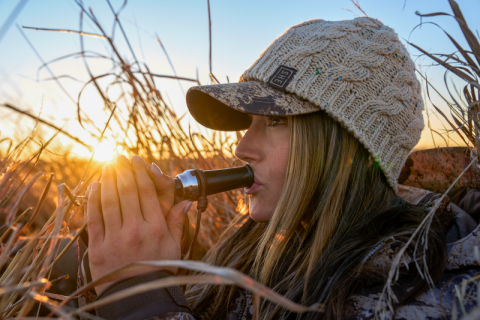
Your Guide To Selecting The Right Goose Call
The satisfaction of watching a group of Canada geese confidently landing 10 feet in front of you is undeniable, especially when your well-rehearsed calling convinced them to commit.
Most air-driven calls, regardless of design, have five basic parts: barrel (or mouthpiece), insert, reed, tone board and wedge. The barrel is the end of the call that is placed against the user’s mouth. The insert is the opposite end, where the hand is normally placed. The insert holds the reed, tone board and wedge, which are often referred to as a call’s "guts." Reeds are cut at the factory to match the sound properties of the call or calls they are designed to fit. Some call makers shave reeds to a thin diameter to make a call require less airflow.
Three types of goose calls are prevalent on today’s market: resonant-cavity, flute and short-reed. Each has strengths and weaknesses, though all are capable of successfully calling geese.
Flute Calls
Sean Mann Eastern Shoreman Express Goose Call - TrueTimber DRT
Counted on by multiple champion goose callers and hunters over the years, the Sean Mann Eastern Shoreman Express Goose Call has set a standard for realism and bona fide results in the field. Helping goose hunters deliver the loudest and raspiest calls available, this call helps hunters fill the skies with a full range of Canada goose sounds without a ton of work.
Shop NowBig River Game Calls Long Honker Goose Flute
Equip your next waterfowl hunt with the Big River Game Calls Long Honker Goose Flute, and you'll have lines of geese winging it your way. This goose call is known as the easiest blowing call around. The Long Honker from Big River Game Calls features a long tone channel that enriches the sound as it passes through.
Shop NowFlute-style calls offer a good range of pitch and easy-to-use traits. The long barrel and insert of the flute-style call creates built-in backpressure, allowing goose-fooling sounds to be achieved with some practice.
With practice, a flute caller can make a wide range of goose calls with dead-on pitch and good volume. However, the flute’s design makes it difficult to control during fast-paced calling. To address this limitation, call makers have turned to a design built for total user control and a complete range of goose sounds – the short reed.
Short-Reed Calls
QuackHead Branta Max Goose Call
Use the big mellow sound of giant honkers against them this season with the QuackHead Branta Max Goose Call. Named after the giant subspecies of Canada Goose, this easy blowing design works great for all goose callers over water or grain fields. Polycarbonate call features an easy-to-operate design developing callers will find as easy to use as advanced callers do. Great all-around call for goose season.
Shop NowZink Calls COD Call of Death Polycarbonate Goose Call - Lemon Drop
Put great calling power, volume, and speed on your lanyard this goose season without putting out so much cash with the Zink® Calls COD (Call of Death) Polycarbonate Goose Call. Perfect for finishing geese at close range, this short reed design features Zink's competition caliber worn-in tone channel for nasty and effective low-end sound.
Shop NowShort-reed goose calls became wildly popular in the 1990s, and continue this trend today. Thousands of short-reed calls are on the market. All have the same basic components – barrel, insert, tone board, wedge and a "short" reed. What makes short-reed calls differ from each other are their internal and external dimensions.
Inside the call, reed placement has a huge effect on sound production. Generally, the farther the reed sits from the mouthpiece, the more control a user has over the call. However, sounds from calls with this setup are normally mellower and deeper.
The overall length of the short-reed call also affects sound quality and production. Adding length beyond the reed increases built-in backpressure. This backpressure helps beginners master basic goose sounds. It also assists the experienced caller with one-hand call operation, important when hunting.
Short Reeds: Easy Blowing vs. Easy to Learn
"Easy blowing" is a term used to describe the minimal air stream needed to run short-reed goose calls and is often misinterpreted. An "easy blowing" call is not always an easy call to learn. In fact, calls that require minimal air pressure can be the most challenging to master.
Beginning callers typically force large amounts of air into a call, expecting the increased air volume to make the call work. This is not a proper short-reed method, as air pressure, not volume, makes goose sounds flow.
Like your thumb pressurizing water through the end of a garden hose, air must be manipulated by tongue placement before it enters the call. The tip of the tongue rarely comes into play for basic short-reed calling. Air pressure is controlled by the back, or "arch," of the tongue pushing the air stream against the roof of the mouth.
Practice, practice, practice
Practice is essential to learning any musical instrument. Goose calls are no exception. Make practice fun, and you’ll soon see the rewards of your hard work. There’s no greater thrill in waterfowl hunting than working a flock of big Canada geese into the decoys - "Take `Em!"
Tim Grounds Championship Calls G Force Acrylic Goose Call - Flat Black
Reach out this goose season with proven Tim Grounds sound with the Tim Grounds Championship Calls G Force Acrylic Goose Call. The more powerful, big brother of the proven G Overhauler™, this short reed design helps hunters deliver the same full range of goose vocabulary.
Shop Now- 2405 views






